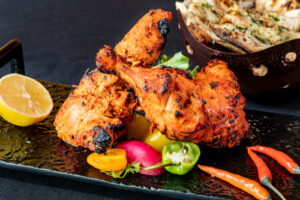What's On This Page?
ToggleDid you know how good Indian cuisine can be for you? I think a lot of the spices they use work like medicine! I’m one of those cooks that combines whatever I find in the fridge or pantry without a plan. I’ll throw spices and foods together like a mad scientist, kind of how I did in Organic Chemistry in 1987 (hoping I wouldn’t blow up the lab).
Recently, I went to my first cooking class, “Secrets of Indian Cuisine” at Sur La Table.

Focusing was difficult since I was distracted by the incredible aroma of the garlic, onion, and seasonings which were simmering in the pot. Our chef taught us how to create the most amazing Chicken Tikka Masala I’ve ever tasted! In between bites and moans, I asked why his tasted so much better than the restaurant version.
He said, “The secret is the spice you use.” He did not use the powdered spices you get from a regular grocery store. His were fresh and he turned both the cumin and coriander seeds into powder using a little electric coffee grinder.
Our eyes widened as he passed around his freshly ground spice with the same store-bought version. The color was completely different. One whiff and his point was made! I decided it’s worth the extra 5 minutes to use spices his way.
Indian spices are some of the healthiest on the planet and can act as an aphrodisiac, antibacterial, immune booster, respiratory aid and digestive tonic. I recommend these:
7 Healthy Indian Spices
1. Garam masala
This is not one spice, it’s a blend which differs regionally. It usually contains cinnamon, nutmeg, cloves, peppercorns, bay leaf and mace (not the kind of mace you spray in a mugger’s face, this “mace” is a waxy red coating off a nutmeg seed.) Garam masala can help you with digestion and respiratory conditions.
2. Nutmeg
It contains myristicin which inhibits an enzyme in the brain that contributes to memory loss. Eugenol, isolated from cloves contains an antiviral that is so strong it can kill the virus associated with shingles and herpes cold sores. Garam masala is used as a finishing spice, not intended to be heated.
3. Curry
This contains a blend of spices, including turmeric known for it’s anti-cancer benefits and ability to reduce inflammation. Curry blends may cause diarrhea in sensitive people. In case you have ever experienced an Indian food reaction, curry is the ‘laxative.’

4. Coriander
It’s from the seeds of the cilantro plant but it tastes nothing like cilantro. Lightly toast them to extract more flavor. This spice reduces insulin and blood sugar and one study suggests it binds heavy metals such as lead.
5. Green cardamom seed
During cooking class, I gently popped open the seeds in a mortar and pestle by tapping them, and then simmered both the seeds and outer shells in oil. Cardamom is rich in minerals, especially potassium so it’s medicinal action on the body is to reduce blood pressure and control blood clot formation.
Chewing the seeds helps with bad breath. What a difference compared to the store-bought powdered type. This spice is used in chai tea. There’s also a black cardamom seed which has more of a smokey flavor.
6. Cumin seed
This is rich in iron in case you have anemia. Cumin is the seed of a small parsley plant. It helps you secrete bile acids and pancreatic enzymes and that helps you break down your food. It also has anti-diabetic actions like the sulfonylurea medicines. Chewing and eating slowly can also help you break down food more efficiently. Cumin contains pyrazines, which are strong antioxidants. Cumin spice improves the action of enzymes in your liver so that you can detoxify better, and this will also help with constipation.
7. Fenugreek
You can buy the seeds and crush them. They have estrogenic properties so some women use them to control hot flashes, or to induce breast milk production. Older folks can benefit from the cholesterol-lowering properties of fenugreek. In a 2011 edition of International Journal of Experimental Pathology lab animals fed a diet laced with fenugreek enjoyed reduced cholesterol by 42 percent and fewer gallstones by 75 percent. Fenugreek also reduced oxidation of lipids in the liver by up to 22 percent.
Ghee is not a spice – but I’m including it here…
Ghee is a type of butter that originated in India. It’s butter that has been slowly melted to separate the milk solids from the golden liquid on the surface. It’s simmered slowly until the milk solids start to brown, so the resulting butter has a nutty, caramel-like flavor and aroma. You can make this at home or buy it an Indian specialty grocery store.
Honorable mention for basmati rice because it’s standard in Indian cuisine. It’s a long-grain rice native to India. You can buy this at any grocery store or specialty market. He soaked his grains for a few hours then poured off the water and cooked it like you would regular rice. This makes it easier to digest.
Tikka Masala sauce Recipe
4 tbsp ghee
1 small yellow onions, sliced
2 tea minced garlic
2 tea minced ginger
1/2 cup tomato paste
12 green cardamom pods
1 tea crushed red chile flakes
4 tea ground turmeric
2 tea ground coriander
2 tea ground cumin
1 can (28 ounce) crushed peeled tomatoes
2 cups heavy whipping cream
2 tea garam masala
Sea salt to taste
1 tbsp lemon juice (to taste)
Directions:
Place ghee into a large saucepan over medium heat. When ghee is melted, add the onion and cook until tender about 5 minutes. Add garlic and ginger and cook another minute longer. Stir in the tomato paste, chili flakes, cardamom pods and seeds (which you gently break apart in a mortar and pestle). Cook and stir frequently until the tomato paste darkens in color, about 5 minutes. Add remaining spices until fragrant, about 2 minutes.
Add the tomatoes to your sauce and bring everything to a boil while stirring. Then reduce heat to simmer, scraping up the browned bits on the bottom of the pot. Stir in the cream and simmer gently, about 15 more minutes. Taste and adjust seasoning with salt and lemon juice as you wish. This is your sauce. Some of you will just pour this over plain chicken and eat it, but the REAL way to make Chicken Tikka Masala is to use this sauce and pour it over chicken that has been marinated. Here’s the recipe to marinate your chicken.
Chicken Marinade
You can do this the night before, or even a few hours in advance.
Mix together the following to cover your chicken:
1/4 cup plain yogurt
1 tbsp minced real ginger (not powdered)
1 tbsp minced garlic
1/4 tea ground cumin
1/4 tea freshly ground mace
1/4 tea freshly ground nutmeg
1/4 tea ground green cardamom
1/4 tea chile powder
1/4 tea turmeric powder
3 tbsp fresh squeezed lemon juice
Add the 6 skinless boneless chicken thighs to marinate
Directions:
Time to cook your marinated chicken. Preheat your oven to 450 degrees. Position the rack in the center. Arrange your chicken on a cooking sheet, or even better put it on top of a wire rack on the cookie sheet. Arrange it all on a single layer and cook thoroughly until it has begun to brown. This should take about 10 to 15 minutes.
To serve:
Place cooked rice on the plate and place your chicken on the plate. Cover with Tikka Masala sauce and serve immediately.

Suzy Cohen, has been a licensed pharmacist for over 30 years and believes the best approach to chronic illness is a combination of natural medicine and conventional. She founded her own dietary supplement company specializing in custom-formulas, some of which have patents. With a special focus on functional medicine, thyroid health and drug nutrient depletion, Suzy is the author of several related books including Thyroid Healthy, Drug Muggers, Diabetes Without Drugs, and a nationally syndicated column.

